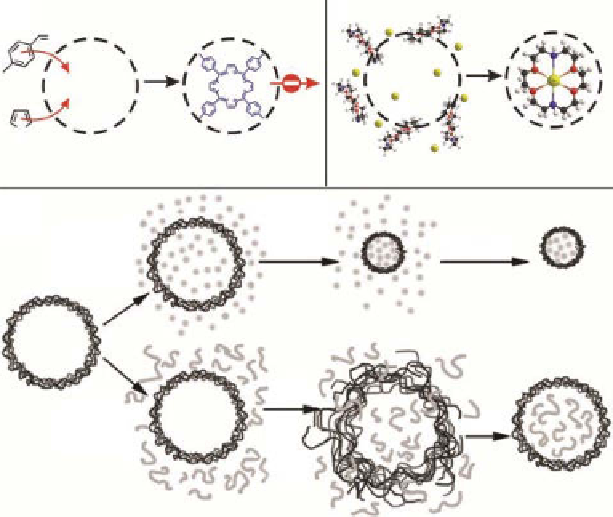Biomedical Engineering Reference
In-Depth Information
(a)
(b)
O
N
NH HN
N
N
H
(c)
Temperature-
induced
shrinkage
Addition
of small
molecules
Washing
Changing
pH
ionic
strength
solvent
Addition
of large
molecules
Washing
Figure 4.11
(a) Combined assembly and entrapment of 5,10,15,20-tetra-p-tolyl-21H,23H-
porphine (H
2
TTP) in a porous NC. The synthesis of H
2
TTP was carried out by a 30 min reflux
in acetic acid. (b) Synergistic coentrapment in porous hollow NCs: individual components
are smaller than the pore size and can diffuse into the capsule. Their complex is bigger than
the pores and cannot escape from the capsule. (Adapted with permission from Ref. [58].
© American Chemical Society.) (c) Schematic representation of the different strategies to gen-
erate postload polymeric multilayer capsules (PmLCs) by changing their physicochemical
environment. (Adapted with permission from Ref. [34]. © Wiley.)
is possible by altering either their own solubility or by altering the permeable PmLC
shell. Reversibly changing the permeability of the PmLC shell to macromolecules
is achieved by changing the pH value, ionic strength, or solvent polarity, which
leads to segregation of the polyelectrolyte network and defects in the shell [60,
62-64]. After macromolecules have passed through the capsule wall, the PmLCs
are transferred to their original medium, thereby entrapping the species in their
hollow void.
NCs can play a dual protective role in biomedical applications (Figs. 4.12 and
4.13). On the one hand, NCs can protect encapsulated molecules from biological
environment, for example, from enzymatic degradation. On the other hand, NCs can
protect the biological environment from potential adverse actions of encapsulated
molecules. molecules otherwise attractive as imaging contrasts may prove to be toxic
to the cells. The combined effect of extremely rapid mass transfer and protective fea-
tures of NCs makes them particularly attractive for the biomedical applications as
smart containers for sensors or imaging contrasts as well as therapeutic agents [65].

Search WWH ::

Custom Search